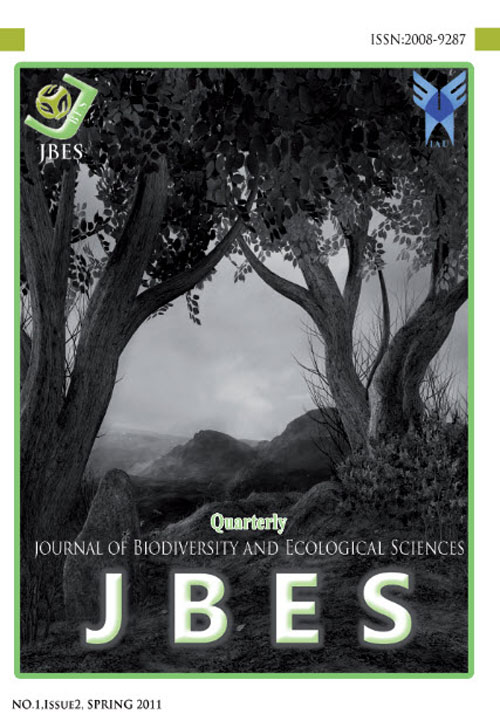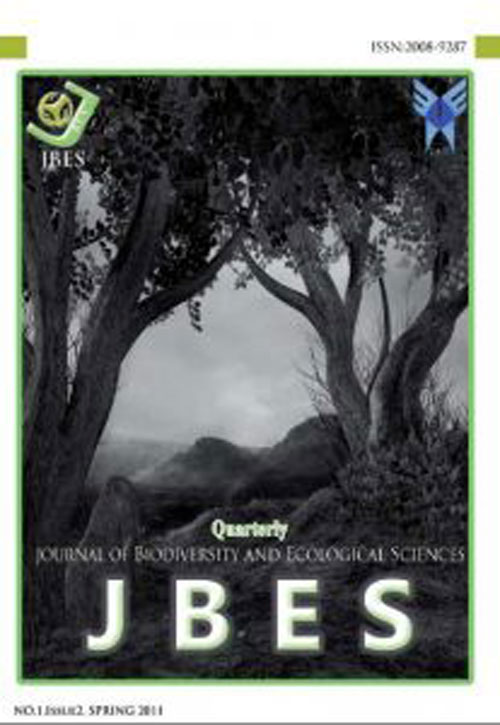فهرست مطالب

Journal of Biodiversity and Ecological Sciences
Volume:5 Issue: 1, 2015
- تاریخ انتشار: 1393/11/30
- تعداد عناوین: 7
-
Pages 1-7Today, indigenous communities are facing a serious crisis of survival due to ecological imbalance and the deteriorating status of the environment. Modernization, changes in cultural, ethical and moral values, the devaluation of indigenous knowledge, lack of traditional practices, dislocation of tribal communities due to large scale development projects and derisory rehabilitation ways are some of the major factors that have altered and weakened both traditions of indigenous communities and nature. The need of the hour is to understand the traditions, knowledge and practices of India in general and tribal communities in particular for environmental conservation. The present paper explores the traditional knowledge of indigenous communities of India particularly Rajasthan in conservation and management of environment. Their storehouse of knowledge leads to many discoveries for modern pharmaceutical products, however patent laws are inadequate to protect traditional knowledge and biodiversity. The rights of tribal people can be defended by creating a community biodiversity register (CBR) of local products and their uses. Proper documentation of traditional tribal knowledge, conservation beliefs and values, environmentally acclimatize land use, natural resource management practices and defense could be supportive in environmental protection. For sustainable conservation of natural resources of the tribal area, there is a great necessity to sensitize the tribal communities about the plantation, afforestation, rainwater harvesting, use of bio-pesticides and bio-fertilizers along with proper sanitation.Keywords: Traditional knowledge, Tribes, Natural resources, Environment, Conservation
-
Pages 8-17Industrialization potential and industrial zoning dependence on bioenvironmental conditions has been under special research focus. The objective of this research was to evaluate East Azarbayjan's industrialization potential and to establish its industrial zoning in light of ecological and none ecological conditions. Having analyzed national and global standards and models, 22 ecological and human related parameters affecting industrial zoning were selected and evaluated. Then, information layers and digital maps were generated. The layers were statistically analyzed and compared within evaluation models of WLC, SAW and TOPSIS to determine each model's sensitivity in industrial zoning. Zoning outcomes by different evaluation models demonstrated that sensitivity to ecological parameters were different among the models. The three models diagnosed differing regional areas that were suitable for industrialization. The statistical comparisons of different 5 categories among the evaluation models showed that the total areas suitable for industrialization varied by model. The total areas suitable for industrial development obtained by TOPSIS method was less than that found by WLC and SAW methods. This was due to prioritizing human related factors in weighing different parameters for industrial zoning by TOPSIS vs. WLC and SAW. Despite the model's differences in the total area suitable for industrialization, the types of areas were widely common among the models. In all models, Myaneh, Shabestar and Charoymagh regions were specified to be suitable for industrialization. It is implied that the above regions should be given priority in policy-making and future investment programming for industrial expansion. Such a priority stems from specific ecological, social and economic properties, their current industrial infrastructures, and suitable population density in these regions.Keywords: Industrial zoning, Multicriteria evaluation model, East Azarbayjan, Environment
-
Pages 18-23The main purpose of this study is the estimating of recreation carrying capacity of Drabad nature and wildlife museum as visitor management tool for museum management to achieve its aim, connects people with wildlife to inspire responsibility and respect for the natural world we share. Based on the recreation carrying capacity, this study attempts to assess the optimum number of people that should be allowed without jeopardizing the surrounding ecological, social and cultural environments. Results showed that the carrying capacity should be 1605 visitors/day. Because the maximum number of daily visitors of Darabad museum during three years is less than calculated recreation carrying capacity, this study suggests that Darabad museum not only has an appropriate condition but also can support more visitors.Keywords: Carrying capacity, Drabad nature, wildlife museum, Tehran, visitor management, Wildlife
-
Pages 24-39This paper aims to recognize the distribution patterns of the functional groups in the studied transects, and to assess the relationships between soil parameters that determine the distribution of these functional groups (FGs) in the study area. A floristic-count list was taken from 142 stands to represent the floristic composition four transects in the study area. The recorded taxa were classified according to four functional groups (trees, shrubs, perennial herbs and annual herbs). The species diversity was calculated as the Shannon-Wiener index and species richness. A set of 94 species, belonging to 33 families, classified according to their spectrum of growth forms to annual herbs, perennial herbs, shrubs (included sub-shrubs) and trees. The dominant FGs (shrubs and annual herbs) were concentrated in transects T3 and T4. The trees were distributed between T1, T3 and T4. Canonical correspondence analysis (CCA) biplots elucidated the differences in responses to environmental gradients between functional groups in the study area. The species diversity indices correlations with the soil gradients showed a significant correlation between the coarse sand and trees diversity. However, water content was significantly affected the annual herbs diversity. The perennial herbs diversity showed significant correlations with 11 soil variables.Keywords: Diversity, desert vegetation, CCA, Egypt, functional traits, vegetation, environment relationships
-
Pages 40-45Heavy metals are some of the most pollutants in urban areas due to vehicle, industry, waste disposal and other human activities. The purpose of this study was to evaluate concentrations of nickel, chromium and copper in leaf and root of pine, cypress, plantain and ash from three sites (heavy traffic, moderate traffic and control) in Isfahan, Iran, differentially impacted by pollution. Heavy traffic (Azadi St) and control sites (Sabahi St) had the highest and lowest amount of nickel and copper concentrations, respectively in all studied species. Moderate traffic site (Ahmadabad St) had the highest concentrations of Cr in leaf and root. The highest correlation coefficients between traits were related to Cu in leaf vs. Ni in leaf and Cu in root vs. Ni in root indicating positive influence of leaf and root to absorb these metals from soil, water and air. The order of heavy metal concentration (mg/kg) in plants leaves and roots were found in as follows: Cu>Ni >Cr. The higher Cu, Ni and Cr contents in leaves rather than in roots in all studied sites illustrated a contribution of significant atmospheric deposition. The best accumulator plant species for Ni, Cr and Cu from polluted sites was Pinus eldarica Medw.Keywords: Air pollution, correlation coefficient, heavy metals
-
Pages 46-50The purpose of this study is to assess the possible contamination of the groundwater by heavy metals derived from sewage sludge through a plot study. For this purpose, two experimental plots, each size 2 by 10 m at Wastewater Treatment Plant-Shoush was prepared. A pvc drainage pipe was installed in one meter depth of each plot to collect the leached water. The first plot was irrigated with pipe water as control plot. The second one with sewage sludge from Shoush wastewater treatment Plant where is located in the south of Tehran. Soil samples were taken from the topsoil to 100 cm depth, each sample for every 10 cm depth from each plot. Cr, Ni and Pb concentration was measured as a function of depth after 150 days. Hydrus-1D was calibrated for heavy metals transport in the site. Modeling and experimental results were nearly the same. Simulation results for plot 2 indicated small risk of groundwater contamination. However high concentration of heavy metals near the soil surface raises a concern about leaching as macro pore and preferential flow. Simulation results for plot 2 indicates that in Hydrus -1D adsorption parameters were estimated in order to allow a deeper transport of heavy metals which had actually occurred duo to macro pore flow.Keywords: Hydrus 1D, heavy metals, sewage sludge, transport, wastewater
-
Pages 51-60Tourism is one of the largest and most popular activities in the developing world. Development activities in this industry, especially in natural areas such as national parks and protected areas has caused, trends in pandemic planning and management activities should be taken to ensure ecological balance also plays an important role in supplying the demand of recreational of the people. Bamu National Park because of its beautiful scenery and rich biodiversity of the high power nature has to attract tourists. The aim of this study was to identify weaknesses, strengths, opportunities and threats as well as nature study area is the development strategy for hiking in the area. To achieve this goal, the matrix method is used to assess the internal and external factors. After the first field visit frequently, weaknesses, strengths, opportunities and threats were identified and then hiking in the area, based on questionnaire prepared by the relevant authorities, tourists and these were prioritized. The results show that in the region of 9 to 13 internal strengths internal weaknesses and external opportunities 7 vs. 8 external threats can be identified.The four competitive strategies - aggressive (SO), diversity (ST), Weekly (WO) and defensive (WT) was presented by the development of tourism in the region.Keywords: tourism, analysis, SWOT, Bamu National Park, development


